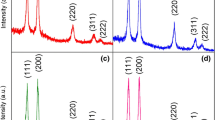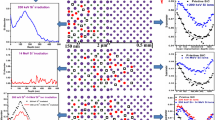Abstract
InP (001) samples were irradiated with 200 MeV Au ions at different fluences. The surface nanotopographical changes due to increasing fluence of swift heavy ions were observed by Atomic Force Microscopy (AFM), where the onset of a large increase in surface roughness for fluences sufficient to cause complete surface amorphization was observed. Transmission Electron Microscopy (TEM) was used to observe bulk-ion tracks that formed in InP, and high resolution TEM (HRTEM) revealed that single-ion tracks might not be amorphous in nature. Surface-ion tracks were observed by AFM in the form of ill-defined pits (hollows) of ~12 nm in diameter (width). In addition, Rutherford backscattering was utilized to follow the formation of disorder to amorphization in the irradiated material. The interpretation of the large increase in surface roughness with the onset of amorphization can be attributed to the plastic phenomena induced by the change of states from crystalline to amorphous by ion irradiation.
Similar content being viewed by others
References
P. C. Srivastava, V. Ganesan, and O. P. Sinha, Nucl. Instrum. Methods Phys. Res. B 187(2), 20–230 (2002).
P. C. Srivastava, V. Ganesan, and O. P. Sinha, Rad. Meas. 36, 671–674 (2003).
P. C. Srivastava, V. Ganesan, and O. P. Sinha, Nucl. Instrum. Methods Phys. Res. B 222, 491–496 (2004).
J. P. Singh et al., Nucl. Instrum. Methods Phys. Res. B 179, 37–41 (2001).
J. P. Singh et al., J. Appl. Phys. 90, 5968–5972 (2001).
R. L. Dubey et al., Nucl. Instrum. Methods Phys. Res. B 257, 287–292 (2007).
S. Klaumunzer and G. Shumacher, Phys. Rev. Lett. 51, 1987–1990 (1983).
M. Hou, S. Klaumunzer, and G. Shumacher, Phys. Rev. B 41(2), 1144–1157 (1989).
M. J. Demkowicz and A. S. Argon, Phys. Rev. Lett. 93(2), 025505 (2004).
R. Bhadra, Phys. Rev. B 38, 12656–12659 (1998).
C. A. Volkert, J. Appl. Phys. 70, 3521–3527 (1991).
C. A. Volkert and A. Polman, Mater. Res. Soc. Symp. Proc. 235, 3–14 (1992).
H. Trinkaus and A. I. Ryazanov, Phys. Rev. B 74, 5072–5075 (1995).
M. Chicoine et al., Phys. Rev. B 56, 1551–1560 (1997).
L. Cliche, S. Roorda, and R. A. Masut, Nucl. Instrum. Methods Phys. Res. B 96, 319–322 (1996).
L. Cliche, S. Roorda, and R. A. Masut, Appl. Phys. Lett. 65, 1754–1756 (1994).
A. S. Khalil, JINR Preprint No. E14-27-173 (Dubna, 2007).
A. Hedler, S. L. Klaumunzer, and W. Wesch, Nature Mater. 3, 804–809 (2004).
T. van Dillen et al., Appl. Phys. Lett. 84, 3591–3593 (2004).
P. Schmuki et al., Appl. Phys. Lett. 70, 1305–1307 (1997).
C. Riedel and R. Spohr, Radiat. Eff. 42, 69–75 (1979).
O. Herre et al., Phys. Rev. B 58, 4832–4837 (1998).
J. F. Gibbons, Proc. Inst. Electr. Eng. 60, 1062–1096 (1972).
J. Colin, D. Lesueur, and J. Grilhe, Philos. Mag. A 81, 857–866 (2001).
Glassy Metals II. Topics in Applied Physics, Ed. by H. Beck and H. J. Guntherdot (Springer, Berlin, 1983), Vol. 53.
V. V. Brazhkin et al., J. Non-Cryst. Solids 212, 49–54 (1997).
J. L. Feldman, J. Q. Broughton, and F. Wooten, Phys. Rev. B 43, 2152–2158 (1991).
M. D. Kluge and J. R. Ray, Phys. Rev. B 37, 4132–4136 (1988).
C. Mathioudakis and P. C. Kelires, J. Non-Cryst. Solids 266–269, 161–165 (2000).
V. V. Brazhkin, Phys. Rev. B 56, 990–993 (1997).
L. R. Testardi and J. J. Hauser, Solid State Commun. 21, 1039–1041 (1977).
R. P. Sharma et al., J. Appl. Phys. 66, 152–155 (1989).
J. Zuk, H. Kiefte, and M. Clouter, J. Appl. Phys. 73, 4951–4954 (1993).
Author information
Authors and Affiliations
Corresponding author
Additional information
The text was submitted by the authors in English.
Rights and permissions
About this article
Cite this article
Khalil, A.S., Chadderton, L.T., Didyk, A.Y. et al. Surface modifications by swift heavy-ion irradiation of indium phosphide. Phys. Part. Nuclei Lett. 5, 481–487 (2008). https://doi.org/10.1134/S1547477108050130
Received:
Published:
Issue Date:
DOI: https://doi.org/10.1134/S1547477108050130




